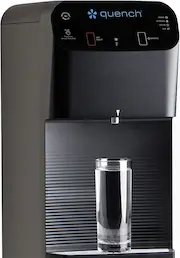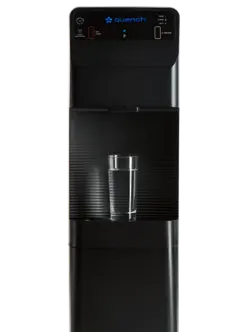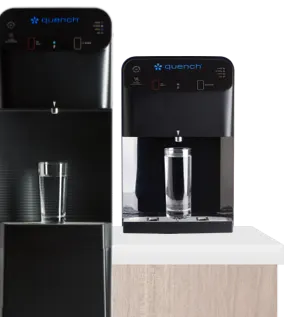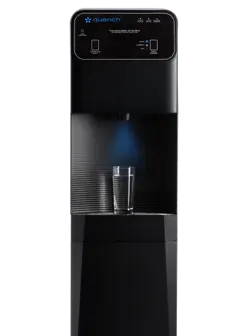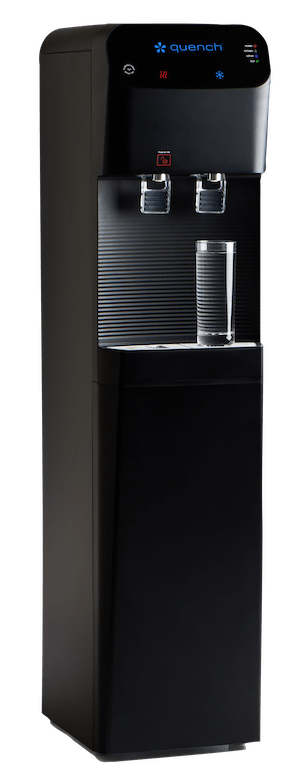Flavorful water might seem like a bit of an oxymoron to the average person. Yet, ask any water expert and they will tell you otherwise. The taste of tap water can vary from one location to another, especially if you do not use a filtered water dispenser. If your tap water tastes a little off, you can usually blame the displeasing flavor on one of three culprits: chemicals used to treat your local water, environmental contaminants, or eroding metal from old plumbing pipes.
If your water is tasting funky, we imagine it’s not smelling too great either. Our sense of smell is our first line of defense that lets us know our water is off before we ingest it. Click here to gain a better sense of why your water might smell bad and how you can fix it.
Perhaps your water managed to pass the smell test, but it isn’t sitting right in your mouth. Read on to get a sense of what different flavors can tell you about the condition of your local water supply, whether it may be harmful, and what you can do about it.
What gives your water its unique taste?
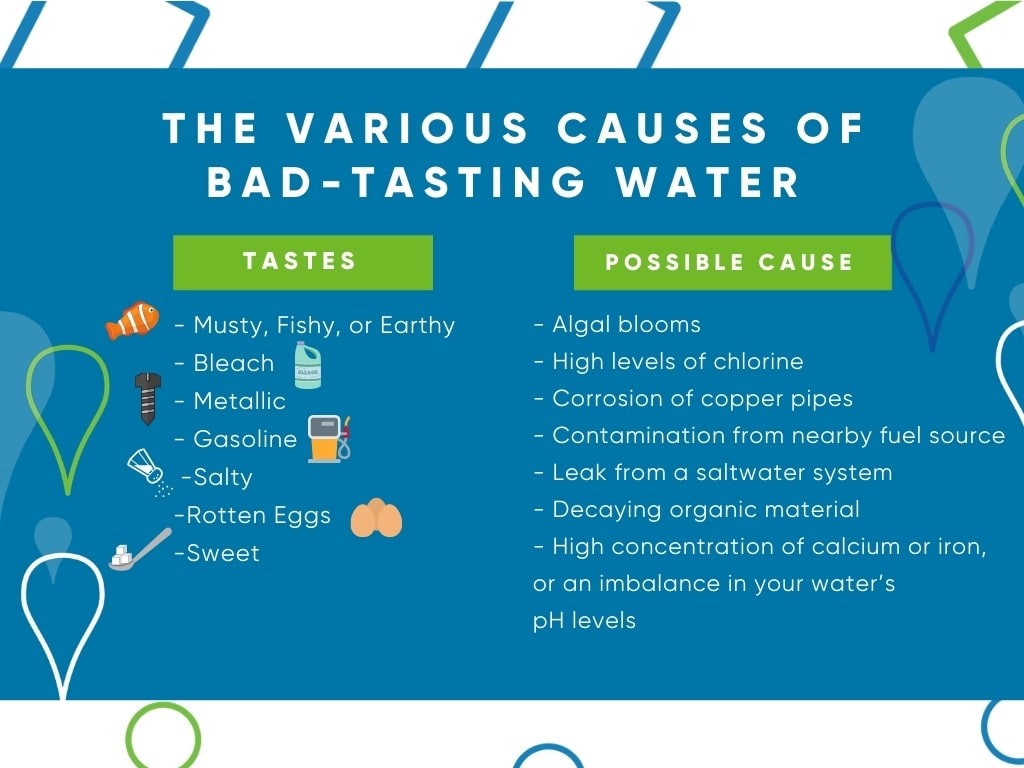
The flavor of your water is influenced by a delicate blend of minerals, sediments, and contaminants. It’s up to water facilities to implement the right treatment processes and use the appropriate water filtration systems to ensure surrounding communities receive the cleanest, best-tasting water around.
Most U.S. residents get their filtered drinking water from municipal systems, which draw from surface sources like rivers and lakes or groundwater. Municipal water travels from its source to treatment plants, which correct for safety and taste. From there, it travels through underground pipes and into your home or office building. Any stage of that journey can influence your water’s taste. Below, we listed bad flavors often found in drinking water and what those flavors might indicate about the contents of your H2O.
Musty, Fishy, or Earthy
When something smells fishy, it’s often a cause for concern. When your tap water tastes fishy, it’s usually the result of an algae outbreak. Fishy, musty, or earthy smells and tastes often indicate an algal bloom in your nearby surface water source. Algae is filtered out and usually rendered innocuous during the water treatment process. Oftentimes, the harmless smell and taste leftover from the blooms can often linger even in filtered water that is safe to drink.
Bleach
If you take a sip of tap water and you’re immediately reminded of bathroom cleaner, you may be drinking water with elevated levels of chlorine. A bleachy aftertaste is hardly enjoyable, but it’s one of the most common complaints concerning bad-tasting tap water. After all, over 98 percent of U.S. water supply systems that disinfect drinking water use chlorine. The EPA requires water treatment facilities to disinfect with chlorine since the chemical can effectively remove waterborne illnesses. Occasionally, your water might get over-chlorinated, and when that happens, you’ll notice a bleachy taste. Chlorine is safe to consume in small doses. The CDC says chlorine levels up to 4 parts per million (ppm) are considered safe in drinking water. Meanwhile, chlorine can be smelled at levels as low as 1 ppm. For comparison, the basic balance of chlorine to water in a pool is between 1 and 3 ppm.
Metallic
Bitter or metallic water can indicate the presence of copper in your water, usually from the corrosion of copper pipes, or an elevated level of total dissolved solids (TDS). At low safe levels, you can taste copper in your water. Water with copper levels at or above 60 ppm can be dangerous to human health. Consumption of high levels of copper may cause nausea, vomiting, diarrhea, stomach pains, and headaches. Talk to your doctor if you are concerned about copper poisoning.
Metallic-tasting water might also be a sign of high amounts of iron, manganese, and zinc. While iron and manganese are naturally occurring, zinc can enter your water supply through corrosion of galvanized pipes. All three metals are safe to drink at low levels—although elevated levels of iron and manganese tend to stain laundry, plumbing fixtures, and appliances.
Gasoline
Taking a swig of liquid that tastes like it could fuel your car is a definite cause for concern. It can also be dangerous. Gasoline-tasting water may indicate contamination from a nearby fuel source or contamination from an animal falling into your water system. If the water in your building smells like gas, contact your water company immediately, as ingesting it could have adverse health effects.
Salty
Chugging a glass of filtered drinking water with high concentrations of chloride ions and/or sulfates can leave a person feeling salty. Briny water can indicate a leak from a saltwater system. During wintertime, areas that treat roads with salt may also experience a saltier water flavor, as snow melts and carries salt into groundwater supplies. In most cases, water that tastes salty is safe to drink. However, it’s still important to get your water tested since contaminated water tends to damage pipes.
Rotten Eggs
A lingering taste of rotten eggs in your mouth is usually the worst side effect of swallowing water with sulfur bacteria. Various naturally occurring bacteria, sulfates, or hydrogen sulfide due to organic material decaying may give water a rotten taste. It’s generally harmless, though. If you taste rotten eggs when drinking hot water only, this may be the result of a chemical reaction within your hot water heater as opposed to your water supply.
Sweet
A spoonful of sugar helps the medicine go down. When it comes to water, though, we can do without that sweet taste. Water with a sweet aftertaste may be a sign your water has high concentrations of naturally occurring minerals. It can also indicate an imbalance in your water’s alkaline or pH levels. Though surprising, it is safe for human consumption.
Flat
Every once in a while, the taste of water falls flat. If you down a glass of H₂O and you notice a complete lack of flavor, you’re probably sipping on distilled water or reverses osmosis (ro) water. Generally speaking, ro water and distilled water are safe to drink in small amounts. It might not taste refreshing, though, since ro water and distilled water lack healthy minerals like calcium, sodium, and magnesium. Those minerals can increase water’s alkalinity and allow your body to absorb water more readily and hydrate faster.
Our quenchWATER+ strikes the perfect balance of filtered water, minerals, and electrolytes!
If you want your water to have the same crisp mouthfeel every time you release the tap, switch to quenchWATER+. quenchWATER+ is Quench branded electrolyte and mineral-infused ro water. It’s produced using a state-of-the-art filtration technology used by our filtered water coolers, the Q7 and the Q5. quenchWATER+ is filtered on demand through our proprietary 5-filter setup that includes a ro system. This special filtration technology removes contaminants and bad tastes while adding minerals, electrolytes, and alkalinity to create amazing tasting water.
Get in Touch With a Local Water Expert
If you are concerned about what is in your water, you can purchase test kits that will check the levels of hydrogen sulfide, sulfate, sulfur bacteria, and iron bacteria. Quench local water experts are available to you as well. Give us a call and we’ll recommend the best filtered water cooler for your location and company.
Ready to make the switch to safe, great-tasting water? Call a Quench Water Expert at 888-877-0571 or take our quiz to see which water filtered dispenser is right for you.
